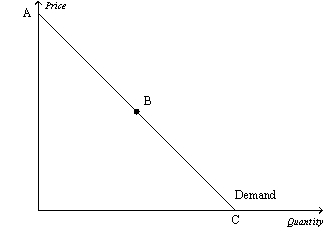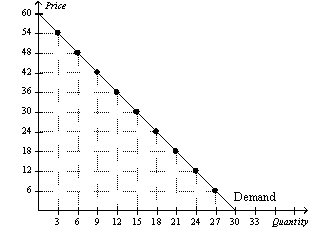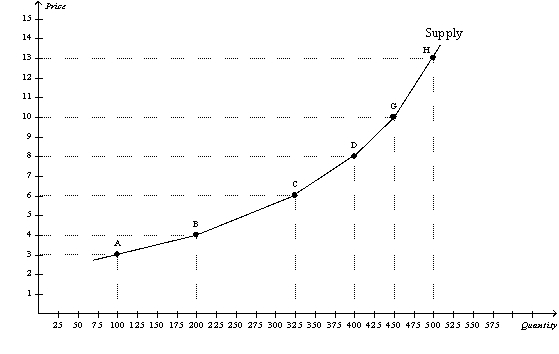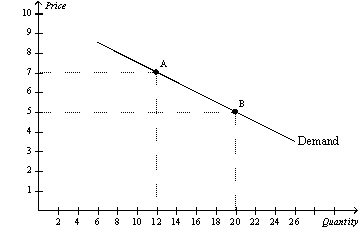A) The flatter supply curve represents a supply that is inelastic relative to the supply represented by the steeper supply curve.
B) The steeper supply curve represents a supply that is inelastic relative to the supply represented by the flatter supply curve.
C) Given two prices with which to calculate the price elasticity of supply,that elasticity is the same for both curves.
D) A decrease in demand will increase total revenue if the steeper supply curve is relevant,while a decrease in demand will decrease total revenue if the flatter supply cure is relevant.
F) B) and C)
Correct Answer

verified
Correct Answer
verified
True/False
When demand is inelastic,a decrease in price increases total revenue.
B) False
Correct Answer

verified
Correct Answer
verified
Multiple Choice
Which of the following statements about the price elasticity of demand is correct?
A) The price elasticity of demand for a good measures the willingness of buyers of the good to buy less of the good as its price increases.
B) Price elasticity of demand reflects the many economic,psychological,and social forces that shape consumer tastes.
C) Other things equal,if good x has close substitutes and good y does not have close substitutes,then the demand for good x will be more elastic than the demand for good y.
D) All of the above are correct.
F) A) and C)
Correct Answer

verified
Correct Answer
verified
True/False
The demand for soap is more elastic than the demand for Dove soap.
B) False
Correct Answer

verified
Correct Answer
verified
Multiple Choice
Figure 5-4  -Refer to Figure 5-4.The section of the demand curve from B to C represents the
-Refer to Figure 5-4.The section of the demand curve from B to C represents the
A) elastic section of the demand curve.
B) inelastic section of the demand curve.
C) unit elastic section of the demand curve.
D) perfectly elastic section of the demand curve.
F) B) and D)
Correct Answer

verified
Correct Answer
verified
Multiple Choice
If the price elasticity of demand for a good is 0.4,then a 10 percent increase in price results in a
A) 0.4 percent decrease in the quantity demanded.
B) 2.5 percent decrease in the quantity demanded.
C) 4 percent decrease in the quantity demanded.
D) 40 percent decrease in the quantity demanded.
F) None of the above
Correct Answer

verified
Correct Answer
verified
Multiple Choice
Which of the following statements does not help to explain why government drug interdiction increases drug-related crime?
A) The demand for illegal drugs is inelastic.
B) Interdiction results in drug addicts having a greater need for quick cash.
C) Interdiction results in an increase in the amount of money needed to buy the same amount of drugs.
D) Government drug programs are more lenient now with drug offenders than they were in the 1980s.
F) None of the above
Correct Answer

verified
Correct Answer
verified
Multiple Choice
Figure 5-5  -Refer to Figure 5-5.At a price of $12 per unit,sellers' total revenue amounts to
-Refer to Figure 5-5.At a price of $12 per unit,sellers' total revenue amounts to
A) $150.
B) $200.
C) $288.
D) $364.
F) A) and C)
Correct Answer

verified
Correct Answer
verified
Multiple Choice
Demand is said to have unit elasticity if elasticity is
A) less than 1.
B) greater than 1.
C) equal to 1.
D) equal to 0.
F) A) and B)
Correct Answer

verified
Correct Answer
verified
Multiple Choice
Figure 5-13  -Refer to Figure 5-13.Using the midpoint method,what is the price elasticity of supply between points D and G?
-Refer to Figure 5-13.Using the midpoint method,what is the price elasticity of supply between points D and G?
A) 1.89
B) 1.26
C) 0.53
D) 0.34
F) All of the above
Correct Answer

verified
Correct Answer
verified
Multiple Choice
To determine whether a good is considered normal or inferior,one could examine the value of the
A) income elasticity of demand for that good.
B) price elasticity of demand for that good.
C) price elasticity of supply for that good.
D) cross-price elasticity of demand for that good.
F) A) and D)
Correct Answer

verified
Correct Answer
verified
True/False
The demand for bread is likely to be more elastic than the demand for solid-gold bread plates.
B) False
Correct Answer

verified
Correct Answer
verified
True/False
Cross-price elasticity is used to determine whether goods are substitutes or complements.
B) False
Correct Answer

verified
Correct Answer
verified
Multiple Choice
If the price elasticity of demand for aluminum foil is 1.45,then a 2.4% decrease in the price of aluminum foil will increase the quantity demanded of aluminum foil by
A) 1.66%,and aluminum foil sellers' total revenue will increase as a result.
B) 1.66%,and aluminum foil sellers' total revenue will decrease as a result.
C) 3.48%,and aluminum foil sellers' total revenue will increase as a result.
D) 3.48%,and aluminum foil sellers' total revenue will decrease as a result.
F) B) and C)
Correct Answer

verified
Correct Answer
verified
Multiple Choice
Table 5-6
 -Refer to Table 5-6.Which of the three supply curves represents the least elastic supply?
-Refer to Table 5-6.Which of the three supply curves represents the least elastic supply?
A) supply curve A
B) supply curve B
C) supply curve C
D) There is no difference in the elasticity of the three supply curves.
F) None of the above
Correct Answer

verified
Correct Answer
verified
Multiple Choice
When the price of a good is $5,the quantity demanded is 120 units per month;when the price is $7,the quantity demanded is 100 units per month.Using the midpoint method,the price elasticity of demand is about
A) 0.55.
B) 1.83.
C) 2
D) 10.
F) A) and D)
Correct Answer

verified
Correct Answer
verified
True/False
The cross-price elasticity of garlic salt and onion salt is -2,which indicates that garlic salt and onion salt are substitutes.
B) False
Correct Answer

verified
Correct Answer
verified
Multiple Choice
Figure 5-4  -Refer to Figure 5-4.The section of the demand curve from A to B represents the
-Refer to Figure 5-4.The section of the demand curve from A to B represents the
A) elastic section of the demand curve.
B) inelastic section of the demand curve.
C) unit elastic section of the demand curve.
D) perfectly elastic section of the demand curve.
F) C) and D)
Correct Answer

verified
Correct Answer
verified
Multiple Choice
Figure 5-3  -Refer to Figure 5-3.Between point A and point B on the graph,demand is
-Refer to Figure 5-3.Between point A and point B on the graph,demand is
A) perfectly elastic.
B) inelastic.
C) unit elastic.
D) elastic,but not perfectly elastic.
F) A) and C)
Correct Answer

verified
Correct Answer
verified
Multiple Choice
A key determinant of the price elasticity of supply is the time period under consideration.Which of the following statements best explains this fact?
A) Supply curves are steeper over long periods of time than over short periods of time.
B) Buyers of goods tend to be more responsive to price changes over long periods of time than over short periods of time.
C) The number of firms in a market tends to be more variable over long periods of time than over short periods of time.
D) Firms prefer to change their prices in the short run rather than in the long run.
F) B) and D)
Correct Answer

verified
Correct Answer
verified
Showing 301 - 320 of 409
Related Exams